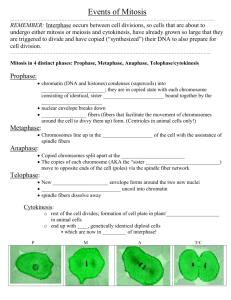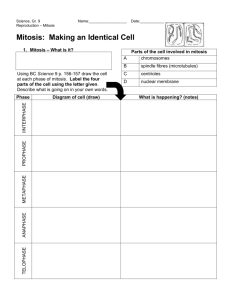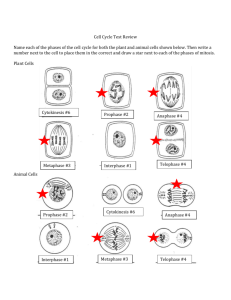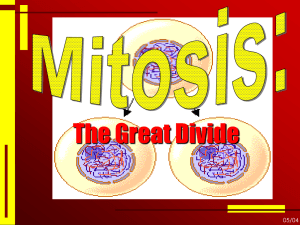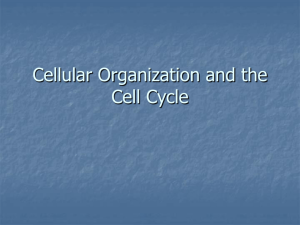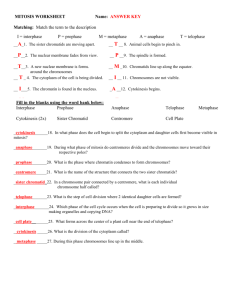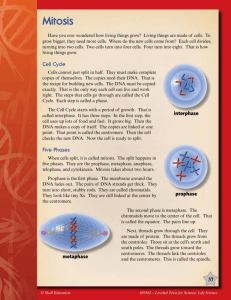Ch. 9 Worksheet Answer Key
advertisement
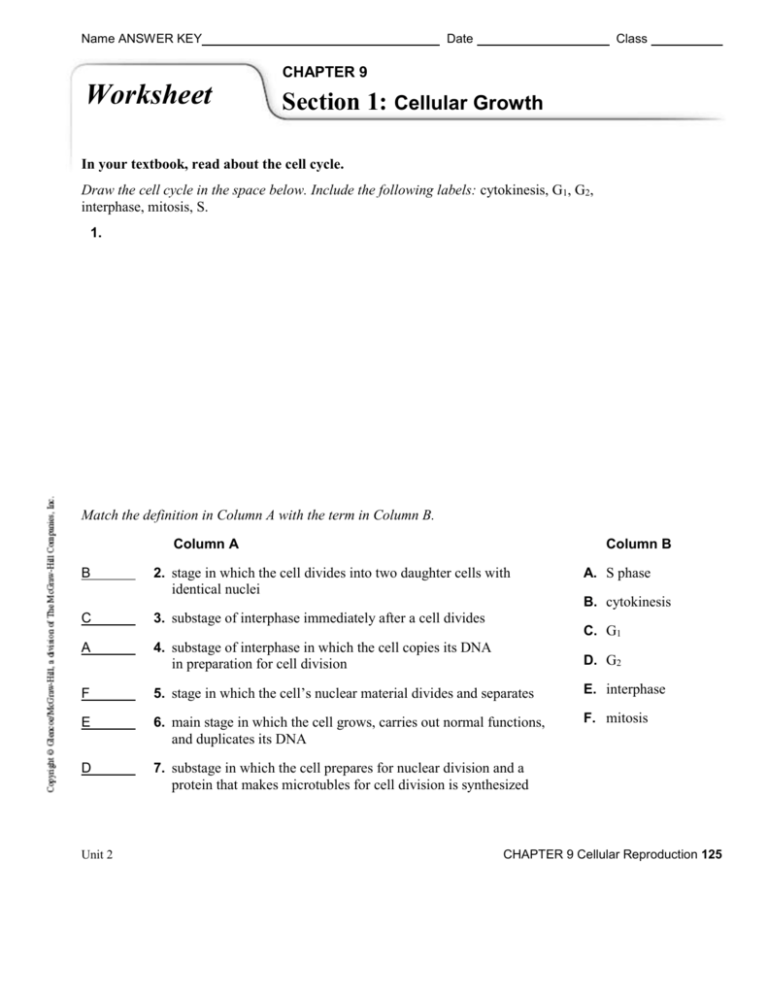
Name ANSWER KEY Date Class CHAPTER 9 Worksheet Section 1: Cellular Growth In your textbook, read about the cell cycle. Draw the cell cycle in the space below. Include the following labels: cytokinesis, G1, G2, interphase, mitosis, S. 1. Match the definition in Column A with the term in Column B. Column A B Column B 2. stage in which the cell divides into two daughter cells with identical nuclei A. S phase B. cytokinesis C 3. substage of interphase immediately after a cell divides A 4. substage of interphase in which the cell copies its DNA in preparation for cell division D. G2 F 5. stage in which the cell’s nuclear material divides and separates E. interphase E 6. main stage in which the cell grows, carries out normal functions, and duplicates its DNA F. mitosis D 7. substage in which the cell prepares for nuclear division and a protein that makes microtubles for cell division is synthesized Unit 2 C. G1 CHAPTER 9 Cellular Reproduction 125 Name Date Class CHAPTER 9 Worksheet Section 2: Mitosis and Cytokinesis In your textbook, read about the stages of mitosis. For each statement below, write true or false. T 1. The nuclear membrane disintegrates during prophase. T 2. Microtubules move chromatids to the poles of the cell during anaphase. F 3. Chromosomes reach the poles of the cell during metaphase. T 4. The cell’s chromatin condenses into chromosomes during prophase. F 5. The nuclear envelope re-forms during anaphase. T 6. Chromosomes attach to spindle fibers and line up along the equator of the cell during metaphase. F 7. The nucleus reappears during prophase. F 8. Centrioles migrate to the poles of the cell during telophase. T 9. Chromatids are pulled apart during anaphase. F 10. The first stage of mitosis is telophase. T 11. The chromosomes decondense or unwind during telophase. T 12. One of the shortest stages of mitosis is metaphase. Label the diagram of the stages of mitosis using lines 13–16. Use these choices: anaphase metaphase prophase telophase 13. Metaphase 14. Anaphase 15. Telophase 16. Prophase 17. Sister Chromatid 18. Centromere 19. Spindle Fibers 20. Centrioles Label the diagrams above using lines 17–20. Use these choices: centrioles centromere 126 Cellular Reproduction CHAPTER 9 sister chromatids spindle fibers Unit 2 Worksheet, Section 2: Mitosis and Cytokinesis continued In your textbook, read about cytokinesis. Animal cell Plant cells Refer to the diagrams above. Respond to each statement. 21. Summarize cell division in prokaryotes. Prokaryotes do binary fission. Prokaryotes duplicate their DNA & attach to the plasma membrane. As cell grows the attached DNA copies are pulled apart. Cell will then complete binary fission Draw the formation of two genetically identical cells in plants in the space below. Include the following labels: cell plate, identical daughter cells, new cell wall. 22. Unit 2 CHAPTER 9 Cellular Reproduction 127 Name Date Class CHAPTER 9 Worksheet Section 3: Cell Cycle Regulation In your textbook, read about the abnormal cell cycle and cancer. Complete the graphic organizer about the causes and prevention of cancer. These terms may be used more than once: carcinogens, cell cycle, cells, DNA damage, genetic changes, spindle fiber failure, the Sun’s ultraviolet rays, tobacco. ANSWERS: #1 – cells; #2 genetic changes; #3 DNA damage; #4 spindle fiber failure; #5 carcinogens; #6 cell cycle, #7 Sun’s UV rays; #8 tobacco Cancer is the uncontrolled growth and division of 1. that is often prevented by that is caused by exposure to unrepaired cell-cycle checkpoints 2. that monitor for 3. or 5. 4. such as and stop the 6. 7. 8. before cytokinesis excessive X rays Complete the table by checking the correct column for each description. Description 9. After a sperm fertilizes an egg, the resulting mass of cells divides until there are about 100 to 150 cells. 10. Some cells go through a programmed death. 11. Unspecialized cells are either embryonic or adult. 12. This event occurs in cells that are damaged beyond repair. 128 Cellular Reproduction CHAPTER 9 Apoptosis Stem Cells x x x x Unit 2
